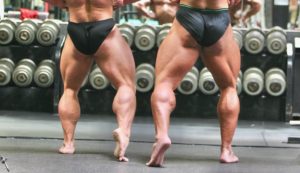
If great calves are your wish, you must sort through the training myths and command them to grow – here’s how!
By Strength Sensei CP
Publication Date: 1996
In all the classical statues from Ancient Greece, the strongest and most powerful heroes always had great calves – and with good reason. The statues were examples of men who had complete physiques. Every portion of their bodies received specific and extensive training: even their calves got repeatedly punished by exercise and labor.
Many of today’s bodybuilders don’t spend much time on their calves, but they should: calf development is a yardstick for the quality of the entire body. Sure, you may have bulging biceps and washboard abs, but how do your calves look? If they vaguely resemble the shape of the barbell you used to build those cannonball delts, your physique is incomplete.
Some bodybuilders are born with great calf definition and can get by with a couple of sets of calf raises a week to maintain their exquisite shape. Yeah, and some people are born into royalty, too. What about the other 99 percent of the population? Well, you’ve got to work at it – train hard, but also train smart!
Let’s take a look at reasons why the calves get neglected and then how to turn skinny, clumsy calves into big, strong, healthy cows.
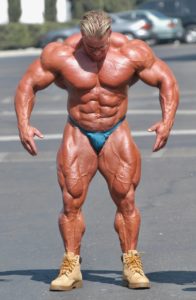
Exceptional lower leg development that looked massive from all angles helped Jay Cutler defeat 8x Mr. Olympia Ronnie Coleman in 2006. (All photos by Miloš Šarčev)
The REAL Reasons for Poor Calf Development
One of the most important factors for calf mass is being blessed with parents who gave you long muscle bellies. The lower your muscle belly inserts on the bone, particularly the gastrocnemius (upper calf), the better your bodybuilding potential. Turn-of-the-century French naturopaths had a saying: “Short tendons, big muscles.” It’s true.
If you have short muscle bellies and are involved in athletic activities other than bodybuilding, you’ll be happy to hear that short muscle bellies are an advantage. A calf with most of the development near the knee area provides better leverage for running and jumping. I understand that movie about basketball hustlers was originally going to be entitled Men with Long Muscle Bellies in the Lower Leg Region Can’t Jump, but it wouldn’t fit on a marquee.
Chris Dickerson won the 1982 Mr. Olympia and had large, diamond-shaped calves but didn’t have to labor on calf machines to build them. Nautilus inventor Arthur Jones said Dickerson’s twin brother didn’t pump iron, but his calves were bigger than his brother’s! And there are many bodybuilders blessed with enormous calves who probably couldn’t tell you how to operate a seated calf-raise machine. However, I disagree with those who say there’s isn’t much you can do to change your calf development. Here are a half dozen reasons most bodybuilders fail to improve:
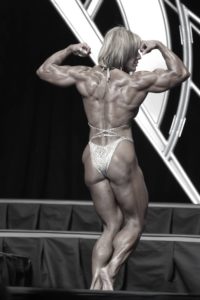
Juliette Bergman built a balanced physique with exceptional calf development. The “Dutch Superwoman” took up bodybuilding in 1983, entered her first Ms. Olympia in 1985, and finally won the event 16 years later in 2001!
- Giving up too soon.Many bodybuilders buy into the “Calves can’t be built – you’ve got to be born with them!” theory and thus don’t commit to consistent training. If a law were imposed that said for every set of biceps curls you do you must also perform a set of calf raises, a year from now the average bodybuilder’s calf measurement would expand by at least two inches!
- Lack of stretch during calf raises.Many bodybuilders who complain of poor calf development perform short, bouncy movements. Using a full range of motion is critical to fully develop the calf muscles, which is why I recommend exercising the calves while standing on blocks that are at least six inches high and slightly rounded.
Rounding the blocks makes the exercise more comfortable, as straight-edged boards can dig into your arches. The best calf blocks are also covered with rubber so that you can perform calf training in bare feet for an even greater range of motion. If you are not accustomed to working your calves through a full range of motion, for your next six calf workouts, hold the bottom position for at least four seconds to “relearn” how to stretch.
- Bending the knees during straight-leg calf exercises.Bodybuilders who unlock their knees while performing standing donkey calf raises are cheating. To convince their poor egos they’re strong, they transfer the load to the quads and glutes by bending their knees.
- Insufficient eccentric overload.Volleyball players and dancers are known for their spectacular calf development, and some exercise scientists suggest it comes from jumping. This is partly true, but I believe the primary growth comes from landing. Studies in biomechanics have shown that the calves absorb a significant portion of the load created during the landing phase of a jump. Negative-accentuated training, in which you raise with two limbs and lower with one, is particularly suitable for calf development.
- Blocked neural supply.An impingement of nerve transmission due to a traumatized spine can block the neural output to the calf, forcing you to use loads that aren’t heavy enough to elicit a growth response. A simple spine-screening and subsequent adjustments by a qualified health practitioner, such as an osteopath or a chiropractor, can often produce additional levels of growth in just a few weeks.
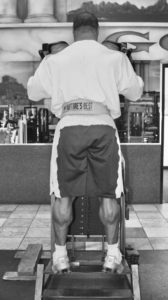
To focus on the gastrocnemius calf muscle, the knees must be locked during exercises such as standing calf raises.
- Excessive connective tissue.If there’s too much connective tissue in the calf region, there’s no room for the muscle to grow. To resolve this problem, there is a surgical procedure available that entails opening the connective known as fascia with a scalpel to allow room for the muscles to grow. However, sports medicine pioneer Dr. Mike Leahy has been known to accomplish the same results with his Active Release Techniques Treatment ® and can often achieve visible results after the very first visit!
Now that we’ve identified several reasons why your calves aren’t growing, let’s see how you can modify your training to solve the problem.
Overcoming Sticking Points in Calf Training
Your calves can grow, but you must have the training knowledge to build them and the willingness to endure the pain required to make them grow. If you’re willing to make a serious commitment to developing your calves, here are six practical suggestions that will vastly increase the effectiveness of your training:
- Use the appropriate repetition protocols.How many reps you should perform in calf work depends on exercise selection. With exercises where the knees are bent, such as seated calf raises, most of the work is performed by the soleus muscle, which lies underneath the gastrocnemius.
The soleus is part of what kinesiologists call the anti-gravity muscles that work when you’re standing. Muscle biopsies and autopsies have revealed that the soleus is made up of approximately 88 percent slow-twitch muscle fibers and, therefore, responds better to higher reps. Consequently, performing sets that last less than 40 seconds won’t do much for the optimal development of the soleus.
During exercises where the knees are straight, such as donkey calf raises and standing calf raises, the gastrocnemius handles most of the weight. The gastrocnemius is composed of approximately 60 percent fast-twitch muscle fibers and responds best to sets that can be completed in approximately 20-40 seconds.
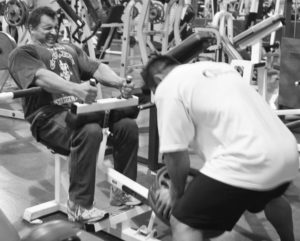
Performing calf raises with the knees bent emphasizes the soleus, a calf muscle consisting of primarily of slow-twitch muscle fibers that respond better to higher reps.
- Pause in the bottom position.This simple trick will do a lot to promote growth in the calf muscles. After you’ve completed the eccentric (lowering) part of a calf exercise, pause in the bottom position before performing the concentric (lifting) part. The length of the pause should be 1-4 seconds, depending on the repetition bracket: the higher the number of reps, the shorter the pause. To give you an idea of how this can work, for sets of 35-50 reps, pause only one second at the bottom; for sets of 6-8 reps, extend the pause to four seconds.
- Reduce lifting speed.Try taking five seconds to lift the weight and five seconds to lower it. Because you won’t use momentum to help you complete the exercise, after 6-8 reps at this slow tempo, you’ll feel a significant build-up of intra-muscular tension in the calf muscles.
- Try unilateral training.If you have difficulty feeling your calves when training, you should experience a new growth spurt once you start training your calves unilaterally. Experiment with single-leg calf raises on the standing calf raise machine and single-leg calf presses on the leg press machine. Concentrating your neutral drive on a single limb in this manner will enable you to maximize the load on the calves.
- Perform calf raises on a hack squat machine.Because both your body and the calf block are at a 45-degree angle, with a hack squat machine it will be mechanically easier to reach the top portion of the range of motion. This position will change the resistance pattern for the calf muscles, challenging the nervous system and thus causing new growth.
- Train all the muscles in the lower legs.For maximum lower-leg development, all areas of the lower leg should be trained: this includes the muscle on the front of the lower leg (such as the tibialis anterior). When you perform dorsiflexion exercises, pause in the bottom position for 1-4 seconds to increase and prolong the muscle tension. It’s also important to stretch the gastrocnemius and soleus muscles between every set of tibialis anterior work. Because the calf muscles are resistant to stretching, use the standing calf machine to provide enough load to ensure you get a good stretch.
Whether or not the calves will ever regain the respect of other muscle groups is a question that should be addressed – my goal was to show those who want to develop bigger calves how to do so. Superior calf development probably won’t change your life, but you’ll be surprised – perhaps even shocked – at how much, and how quickly, these muscles can grow!
